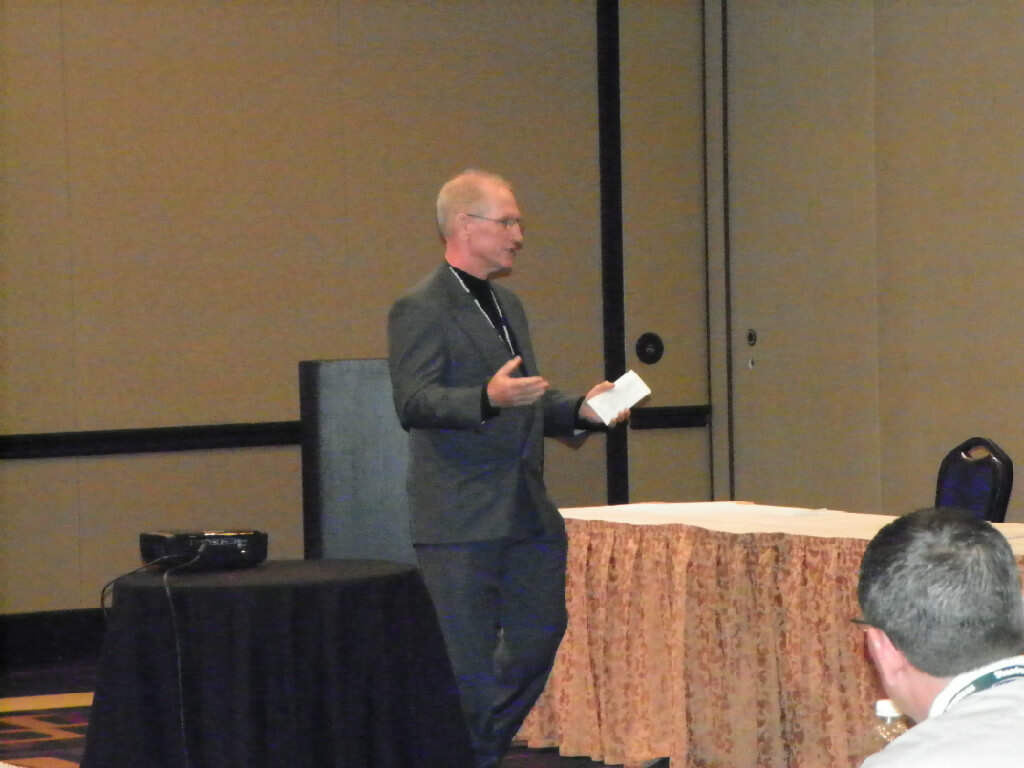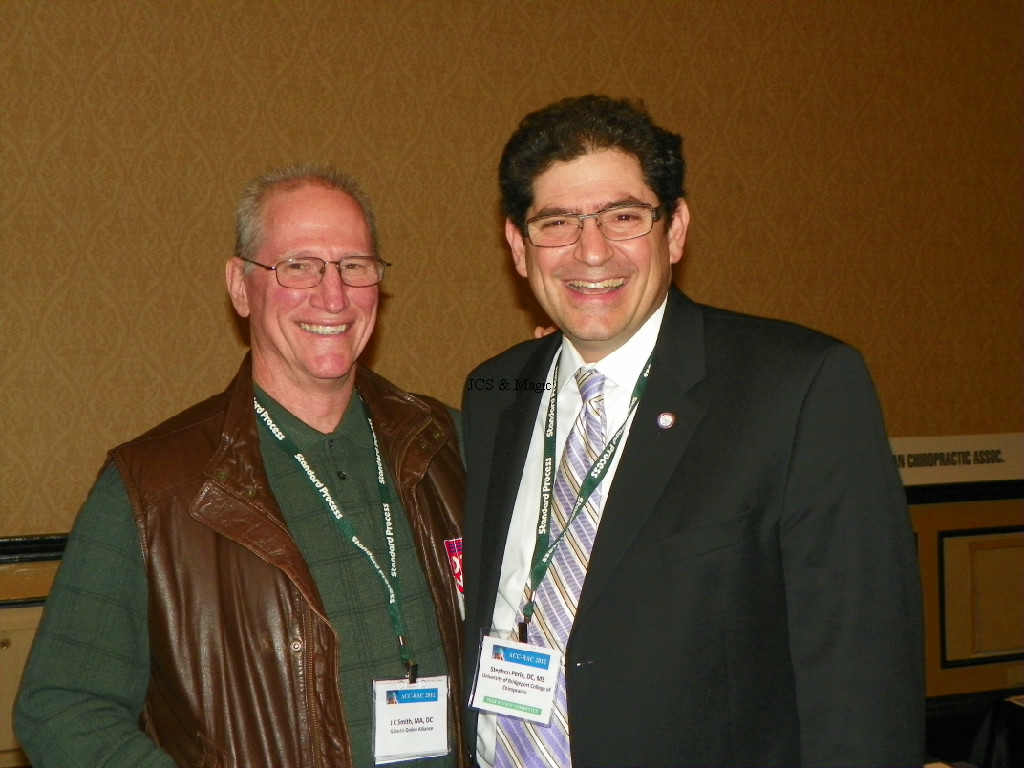Lucky Las Vegas
By
JCS
The Association of Chiropractic Colleges Educational Conference & Research Agenda Conference (ACC-RAC) has to be the best show in the chiropractic profession if you have any intellectual proclivity or scientific curiosity whatsoever left in your professional soul.

Not to be outdone, the National Chiropractic Legislative Conference (NCLC) is also an interesting conference on national politics held in beautiful Washington, DC, and the only thing that could surpass each conference individually would be if both ACC-RAC and NCLC were held together. That is my mind-blowing dream to see the best and the brightest with differing agendas but with the common goal to advance chiropractic together at one conference.
Most field docs don’t know what they’re missing since many only attend license renewal seminars with ol’ time motivational speakers, dubious practice managers, or vendor-sponsored shills, which are all fine in their own different way.
If you feel brain-dead at the end of most license renewal seminars after listening to vendors sell their wares or boring speakers read verbatim from their PowerPoint slides, I guarantee you will be excited and renewed after learning what the best in our profession has to offer. I urge you to attend the next ACC-RAC conference if you want intellectual stimulation based on the latest science.
And certainly in Las Vegas, we got that stimulation and many other thrills!
What Happens In Vegas Doesn’t Always Stay In Vegas
I’m constantly amazed at the serendipitous experiences that occur along the way to, during, and after the conferences I attend. Of course in Las Vegas, lucky is exactly what you want to be and any event held in Sin City is apt to have many unusual and surprising stories.
First of all, if you’re into people-watching, I encourage you to sit at one of the sidewalk cafes on the strip to view the myriad of tourists in Vegas. Indeed, the strange Wal-Martians have nothing over the folks on Las Vegas Blvd. Just one hour watching them makes you understand why we have a healthcare crisis—it’s not a pretty sight. Maybe Jeff Foxworthy is right when he said “there outta be a law against anyone larger than size 8 wearing spandex, ya folla?”

The day before the conference officially began, my wife, Christy, and I spent the afternoon sightseeing. Aside from the luxurious hotels on the strip, her main request was to visit the sight of her favorite show, Pawn Stars, hoping to meet its dufus anti-hero, Chumlee. Ironically, this is the highest rated show on the History Channel. I kid you not.
When our taxi arrived at the pawn store on the old strip in the Fremont section of town, there was a line of 50 or more tourists on the sidewalk waiting to enter. According to the doorman, 4,000 people daily visit their store.
To my wife’s dismay, the television “pawn stars” were not there. My surprise was that the store was not bigger than my office as we followed the line in, we walked to the rear, made a u-turn, and then exited the store within ten minutes. My wife did buy a Chumlee t-shirt, so she was happy nevertheless. I was more bemused at the crowd and the $20 taxi ride to a pawn shop.
Godfather of AMA
From the pawn shop, we went to the new Mob Museum in the old post office building. I highly recommend this to anyone visiting Vegas, especially if you’re a history buff. It’s on par with the Smithsonian museums on the mall in Washington and nearly as shocking as the Holocaust museum.

As we learned, five mob families developed Las Vegas. The mob also had tentacles into all aspects of our society—government, law enforcement, business, drugs, sports, and entertainment. The iron-handed control of the mob made me think of the medical mob and its godfather, Morris Fishbein, who led the AMA from 1924 to 1949 during the same heyday of the mob. Who knows, but it wouldn’t surprise me if this Medical Mussolini took a few lessons from the mafia in his organizational management.
Just as the mafia whacked anyone who opposed them, the medical Godfather Fishbein had the same attitude when he said, “Scientific medicine absorbs from them that which is good, if there is any good, and then they die.”

We also know he was responsible for the arrests of 12,000 chiropractors in the first half of the 20th century and God only knows how many more thousands were run out of towns, publicly humiliated, or suffer nervous breakdowns as George and Jerry McAndrews said happened to their father.
Nonetheless, the Mob Museum was a great lesson in mob history that I’m certain you will enjoy on your next visit. It’s a deal you can’t refuse, ya folla?
Diversity in Chiropractic
The next day the conference officially began. This year’s event combined academicians, researchers, administrators, instructors as well as representatives from CCE, NBCE, and WHO were in attendance. There were also dozens of field docs keen on the learning about leading edge issues in our profession. Unlike most seminars, it is customary at ACC-RAC to have a Q&A session at the end of each workshop that keeps the presenters on their toes as the audience asks pointed questions and makes insightful suggestions. This feedback and exchange of ideas often becomes heated as well as informative and fun for all, unless you’re a presenter having his feet held to the fire by outspoken attendees (no, not me). As I said, if you’re an intellectually curious type, this conference is for you.
The Conference theme was “Diversity of the Chiropractic Workforce.” According to the synopsis of the Opening Plenary Session, “In the next 15 years, the nation is projected to confront an overall shortage of physicians, but the need is, and will continue to be, particularly great for minority physicians. By 2050, racial and ethnic minorities are projected to account for half of the US population.”
This poses a problem for every health profession, especially for chiropractic. Although all health professions have historically consisted of predominantly white males, this will be slowly changing to include more women, people of color, and ethnic origins. The NBCE spokesmen, Mark Christensen and John Hyland, mentioned the Sullivan Report: Missing Persons: Minorities in the Health Professions. (http://www.aacn.nche.edu/Media/pdf/SullivanReport.pdf )
“The Sullivan Commission on Diversity in the Healthcare Workforce finds that African Americans, Hispanics, American Indians, and certain segments of the nation’s Asian/Pacific Islander population are not present in significant numbers. Rather, they are missing! While some outstanding physicians, dentists, and nurses are minorities, access to a health professions career remains largely separate and unequal.”
Of course, this remains true in chiropractic as well. Despite having a diversity of patients, the typical DC remains a middle-age white male. According to the 2009 Survey of Chiropractic Practice data, 77.6% of chiropractic practitioners are male and 22.4% are female. In comparison to the NBCE 1991 Survey of Chiropractic Practice, the percentage of female chiropractors has increased approximately 10%.
The ethic origin of respondents in 2009 were diverse, but sparse for non-white practitioners: Asian/Pacific Islander 2.6%; Black or African American 0.9%; Caucasian 84.9%; Hispanic 1.0%; Native American 0.4%; Other.2%; Mixed 9.0%.

Obviously the face of chiropractic will be changing as our population changes. Other speakers such as David Chapman-Smith of the WFC spoke of cultural competency from the world view, while Fred Zuker, PhD, from Texas Chiro College spoke of the recruitment for diversity in both the faculty and student body.
Dr. Valerie Johnson spoke of her experiences in private practice in Compton, California, as well as a VA doctor. Anupama Kizhakkeveettil, professor of Ayurvedic Medicine at SCUHS, also spoke of her experience as a female practitioner and the patient perspective/idiosyncrasies of Asian patients. Lisa Killinger spoke of caring for the elderly, a fast growing segment of our patient load as the Baby Boomers (like me) enter retirement (unlike me), not only for their musculoskeletal disorders (like me), but with dementia (unlike me).
Stephen “Magic” Perle spoke of life as a Jewish practitioner that made for an interesting story. He recalled an incident as a student in Texas when he found himself among rednecks who openly demonstrated in KKK drag near his college—just think of a chiropractic rendition of “O Brother, Where Art Thou?” Undoubtedly I can see Stephen playing George Clooney’s character as the clever conman eluding the rednecks with his magical wit.
Adding to the diversity of this ACC-RAC conference was a contingent from WHO there to form an alliance with chiropractic. At the closing plenary session, Mark Zeigler, president of Northwestern Health Sciences University, mentioned a possible chiropractic fellowship at the WHO headquarters in Geneva similar to Harvard’s medical resident fellowship already there.
At this 19th conference, 31 workshops and 61 poster presentations covered clinical, educational, research, and topics in diversity. Next year’s conference will focus on “Chiropractic and Healthcare Reform: Improving Outcomes, Delivery, and Affordability of Healthcare,” but will not be held in Las Vegas, presumably Orlando, New Orleans, or Washington (thankfully anywhere other than the Planet Hollywood unless you’re keen on loud rock music blaring everywhere).
For those curious colleagues interested in my presentation, I can happily say my 15 minutes of fame also went well. I had sent beforehand my talk, Wither on the Vine (http://www.chiropractorsforfairjournalism.info/About_JCS.html), and my goal was to squeeze those 14 pages into a 15-minute time-frame.

My audience of academic officers from around the world was receptive to my hyper-speed message and I was grateful to Rob Scott from Life University for his personal endorsement of my book.
Afterwards I spoke to five college presidents who seem interested in my idea to begin creative journalism classes in chiro colleges. I only hope they see the value of such a class in this day and age of mass communication. My call for for the development of chiropractic journalists may be far-flung to some who cannot think out of the traditional box of academia, but the need keeps striking me squarely in the face. As I previously mentioned, too many serendipitous events screamed this need at me throughout my trip.
No Wiggle Room
During the Saturday luncheon, we were shown a movie preview of the upcoming documentary, Medical, Inc. (www.medicalincmovie.com.) by Jeff Hays who formerly produced On Native Soil (www.onnativesoil.com). Jeff spoke of his 50 to 60 interviews with chiro notables of the Wilk v. AMA trial and he and his crew were at the conference to film more people, including me. Mike Flynn had given Jeff my name months before and I had sent him my book for reference. Jeff did say at the luncheon that the film will not be exclusively about chiropractic per se, but about the abuses of the medical and pharmaceutical industries. If you have not seen his 5-minute trailer, click on the links above to see the quality of his work.
Another serendipitous event occurred when The Dr. Phil Show showed aired a program on March 14 with Dr. Fabio Mancini of Parker University. The segment began with Dr. Phil introducing Dr. Mancini as his chiropractor for 14 years and author of the book, The Power of Self-Healing: Unlock Your Natural Healing Potential in 21 Days! https://parker.edu/President-of-Parker-University-Dr-Fabrizio-Mancini-Appears-on-Dr-Phils-Daytime-Talk-Show.aspx
The Foundation for Chiropractic Progress also entertained at lunch the nearly 500 attendees with its infomercials of celebrities, pro athletes, and General Becky Halstead. The F4CP now has over 2,500 members contributing monthly to its goal to disseminate “billions of hits of positive ads”, PSAs, and endorsements in the public arena. I am a member and urge all of you to join this effort, too, since we need all the exposure we can muster. Just remember the foundation’s new motto: “little plus often makes much!”
The F4CP effort also illustrates the lack of chiropractic influence in the main stream media and why our efforts to promote chiropractic are so important. For example, one F4CP infomercial featured its new spokesperson Anthony Field of The Wiggles. I’m not sure what the Wiggles were, but after viewing an interview of Mr. Field, I think it is an Aussie rendition of Sesame Street.
According to the F4CP news release,
“Anthony Field, creator and member of the popular children’s show, The Wiggles, has recently been all of the “buzz” in the media after releasing his new book, How I Got My Wiggle Back. The book shares the struggles Field experienced while dealing with health conditions, including depression and chronic pain, as well as the joy he found after chiropractic care lead to recovery. Although the Foundation is not specifically mentioned in the media segments below, Field has done an outstanding job informing the public about the value of chiropractic care. We are pleased to have him as a part of our F4CP team.”
You can view interviews of him at:
FOX 6, Milwaukee, WI – View Here
FOX 43, Central PA – View Here
ABC 13, Rochester, NY – View Here
Although his story how chiropractic saved his health and career is heart-warming, as fate would have it, the recent edition of People magazine (April 2, 2012) features an article, “Battling My Way Back to the Wiggles,” that at first glance I thought was about Mr. Fields. Indeed, what a coincidence to have just heard of this “Blue Wiggle” at ACC-RAC but, instead of him, it featured his co-star, Greg Page, the “Yellow Wiggle” and his battle with orthostatic intolerance.
In a small 80-word side-bar article, the writers did mention Field’s battle with depression, “Another Wiggle’s Fight.” Instead of his glowing remarks how chiropractic saved his life as we heard in his infomercial, this People article failed to mention his chiropractic care at all. None, zilch, nada—more evidence that chiropractic is not on the radar screen in the lame stream media.
Considering Field’s positive support, it is hard to believe the two Aussie writers from New South Wales who interviewed him for People could omit his strong endorsement of chiropractic care. This is an example of “professional amnesia” as Tony Rosner describes those who forget to mention the role of chiropractic in the treatment of patients.
This is so typical of the main stream media to omit chiropractic at the most opportune time. I still recall the release of the AHCPR low back pain guidelines in 1994 when the TV media purposely excluded chiropractic from their narrative, which I give details at length in my book.
Having a Masters degree in sociology, I’ve applied this academic prowess to the sociology of chiropractic in an attempt to understand our dubious cultural image despite our high clinical success, the supportive research, RCTs, and international guidelines, as well as our high ranking in the Jobs Almanac.
Perhaps the most astounding clue to my query and serendipitous event occurred on our trip back home that perfectly explained this entrenched media bias against chiropractic.
We were listening in the car to an interview broadcast on “On the Media” (NPR, March 18, 2012) when guest Patrick Ball inadvertently alluded to what I believe is the problem we chiropractors seemingly face in the media—that is, a phenomenon he called “citation laundering” of erroneous facts that are regurgitated and passed on as “perceived wisdom” by other newscasters. (http://www.onthemedia.org/2012/mar/16/calculating-body-counts)
The issue of medical “citation laundering” of erroneous claims made against chiropractors is unknown to the public, but it forms the public perception of our image. Since the 1960s, the AMA’s Committee on Quackery repeatedly promoted its slur that “everybody knows chiropractic is an unscientific cult.”
 However, during both the Wilk v. AMA federal antitrust trial and the New Zealand Commission’s Inquiry into Chiropractic, when the medical leaders’ feet were held to the fire in the witness box, they admitted they could not prove this allegation; they were simply repeating lies from their own propaganda.
However, during both the Wilk v. AMA federal antitrust trial and the New Zealand Commission’s Inquiry into Chiropractic, when the medical leaders’ feet were held to the fire in the witness box, they admitted they could not prove this allegation; they were simply repeating lies from their own propaganda.
Although this medical “citation laundering” is obviously based on medical lies, it remains unchallenged in the media as the prevailing “perceived wisdom” that continues despite the new-found research supporting chiropractic care.
Another recent example of citation laundering occurred on NPR’s Morning Edition on February 15th by article by Blake Farmer on military health services featuring the military’s new use of complementary and alternative healthcare—chiropractic, acupuncture, and massage therapy. Military Pokes Holes In Acupuncture Skeptics’ Theory.
As I listened I became excited since I cannot recall when any NPR program had spoken about my profession. However, my hope was soon dashed when former flight surgeon and renowned quack buster Harriett Hall made her typical slur at these CAM professions, which isn’t her first time I might add. Here’s the offensive excerpt:
But Harriet Hall, a former Air Force flight surgeon, shares the skepticism found in many corners of the medical community.
“We call that ‘quack-ademic’ medicine when it gets into medical schools,” she says.
The way she reads the science, acupuncture does no more than a sugar pill. To offer a placebo, she says, is unethical.
Ironically, the placebo effect has been shown to be very prevalent in the medical profession with great success, so her slur was uncalled for on many levels. To suggest chiro care is only placebo laughs in the face of the many RCTs that support our clinical success over anything the medical world has to offer, a fact the quack buster Hall forget to mention. Enjoy this 60 Minutes video about the placebo effect: http://www.cbsnews.com/video/watch/?id=7399362n
I had hoped the days of slurs against chiropractors were deemed politically-incorrect, but obviously I am wrong. Moreover, I was saddened it occurred on my favorite radio network, NPR, a supposedly liberal news outlet. When even a progressive media outlet harbors such medical bias, you know our image is poor. You can read my complaint letter to the executive director @ Letter to NPR.
This inaccurate reporting of chiropractic continues to soil our image and also undermines our rightful role as the cultural authority as primary spine care practitioners, thereby forcing unsuspecting patients to unqualified medical PCPs posing as spine experts who sell patients a ticket on the medical railroad to more costly, less effective, often addictive, and disabling medical treatments of drugs, shots, and disc surgery. Of course, any inquiry by patients about chiro care is met with the standard knee-jerk slurs in most cases. Don’t get me started. (Power of Prejudice)
Push Back Journalism
This misrepresentation and omission of chiropractic will continue until we call out these biased or amnesiac journalists. The time is ripe for this push back considering the recent examples of Rick Santorum and Newt Gingrich complaining of the liberal bias in the media; the sexist slur made by Rush Limbaugh and the racist slur made by the killer of Trayvon Martin also received gross condemnation in the media.
Indeed, it is past time for the chiropractic profession to call out the medical slander and slurs in the media. It’s time for the Fredrick Douglass brand of journalism to replace Uncle Tom.
Again, thinking as a sociologist, the main reason why we haven’t gained positive national attention in the media is primarily due to the fact that no one has told the public about the details of the medical war to eliminate our profession. Although most people know this cold war exists,

Even paid ads by the F4CP were recently rejected by the Archives of Internal Medicine and the American Family Physician Journal, indicating the boycott of chiro continues in medical journals. Until we call out this retrograde attitude, the medical bigots will continue to discriminate against us with impunity.
Just as opponents to inter-racial marriages, homosexuality in the military, and glass ceilings in corporations for women are now considered retrograde by most reporters in American media, we need to make the anti-chiropractic demagoguery appear just as outdated, hurtful, and un-American. But it won’t happen until we push back.
These examples of media bias reaffirms to me and hopefully to you of the need for our colleges to educate a new wave of creative journalists to confront these biased reporters, monitor the news media, and write informative articles about the benefits of our brand of care. We need writers to take the scientific research and health policy issues and translate them to the public so the people can understand the value of our brand of care for Type M, Type O, and Type B disorders.
I shared my idea to begin journalism courses in chiro colleges with the editor of a well known medical newsletter on spine care who chose to remain anonymous for fear of retribution from his own board (what does that tell us?).
His comments were spot on as a seasoned journalist:
I think the idea of making journalism a standard part of the chiropractic educational system is a great idea. I have proposed this repeatedly to key figures in the medical side of the back pain research field, but not sure that any healthcare profession has adopted this approach. If you need any resources on evidence-based journalism, www.Healthnewsreview.org offers all sorts of checklists as well as critiques of major market medical journalism.
Every branch of healthcare has to develop lighting-quick communication abilities. It has been documented, for instance, that drug companies can now publicize a new drug AROUND THE WORLD in about 90 minutes. Healthcare professions have to be adept at communicating rapidly and accurately–both through standard and social media.
A couple more things that might be relevant: When I first started covering the field, researchers used to routinely make fun of chiropractic and of spinal manipulation in general at medical conferences for lack of research. Yet, look at the research response to that challenge. There are now more than 50 RCTs on spinal manipulation (I believe that is an accurate figure, though it is hard to pin down without a formal literature search), showing it has to be as good or better as the therapies to which it has been compared.
Another outcome of that educational/research challenge has been the development of elite, world-class researchers who are DCs. There is long list of great researchers who fit that bill now, from Scott Haldeman onwards. e.g., David Cassidy, Gert Bronfort, Sidney Rubinstein, Eric Hurwitz, Simon French, Bruce Walker, Simon Dagenais et al. Just look at the recent RCT on neck manipulation in Annals of Internal Medicine (Bronfort et al.). Who would have predicted in 1985 that in 2012 the second largest primary care medical journal in the US would be running an RCT where the lead author is a DC—and an editorial where both editorialists come out of the chiropractic tradition?
Another issue that probably doesn’t get mentioned enough is that patients seeking chiropractic for the primary care of back pain may not get exposed to the some of the excesses of the medical field, i.e. opioids, injections, surgery. The opioid debacle–15,000 Americans now die every year from abuse and misuse of prescription opioids–really stemmed from misreading of the evidence in the pain medicine field. But then opioids were widely adopted in primary care medicine, where it is still a dominant back pain treatment despite all the corollary damage.
Yet there hasn’t been all that much reaction in the press to this debacle–despite the point that opioids have never been shown to be an effective treatment for long-term chronic pain. If a treatment developed in chiropractic or one of the ALT/COMP professions–and had never been validated in long-term RCTs and killed thousands of people per year, can you imagine the uproar in the press? It is a telling point.
I do monitor the press on back pain all the time through Google News. And I don’t see a lot of articles on chiropractic as a healthcare profession. I do see quite a few articles on individual DCs who discuss some narrow area of research or promote their practices (I see the same type of articles on MDs).
You might consider prodding researchers at a couple of the chiropractic colleges to do a systematic review of press coverage on chiropractic or on a single topic or study related to chiropractic. Up and coming researchers love doing systematic reviews and getting them on their resumes.
I appreciated his input as one of the premier spine journalists in the nation to develop chiropractic journalists who can use the power of the pen to fight our battles. I only hope our chiro colleges agree with his point of view.
The Bottom Line
As you can see, my trip to Vegas was enjoyable and providential in many ways. The various serendipitous events to and from the conference only reaffirmed my belief in the PR battle we face. As you can gather, the value of my sojourn transcended the classroom itself, a point I hope every reader understands.
So, what are we to do? We’ve already used litigation in the courts and legislation on Capitol Hill to some degree of success, but we cannot win in the court of public opinion unless we can:
- change the prevailing perceived wisdom,
- confront the citation laundering,
- challenge the journalistic amnesia,
- reveal the “acceptable” medical bigotry, and
- push back on the outright slurs some journalists still print.
Indeed, chiro bashing remains the last bastion of acceptable bigotry that goes unchallenged. It is time to push back. I’m about creating an intelligent narrative about the role of chiro care in healthcare reform and the emerging science supporting CAM care as well as the increasing evidence against drugs, shots, and disc surgeries. You can view my 150+ articles @ http://www.chiropractorsforfairjournalism.info/Index_of_Articles.html.
I do hope what happened in Las Vegas at ACC-RAC doesn’t stay in Vegas. The sooner we take this battle across the nation and around the world, the sooner we will stop withering on the vine. We must bring these issues before the public if we are to win in the court of public opinion. Rather than being ashamed of our past self-indulgent demagogues and scalawags, or afraid to speak about the medical cold war to the media, we must confront these fears if we are to progress and bring our healing art to the entire world rather than only 10%.
Lastly, I hope to see many new faces, particularly field docs, among the regular attendees at next year’s conference. I guarantee you will not be disappointed at the quality of topics and speakers, the camaraderie is outstanding, and CE credits are available.

By the way, the trip was lucky for my wife, too. She broke even playing the slots when she won $75 on her last quarter! Indeed, there’s nothing better than a happy wife in Las Vegas.